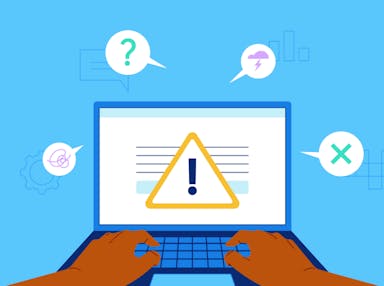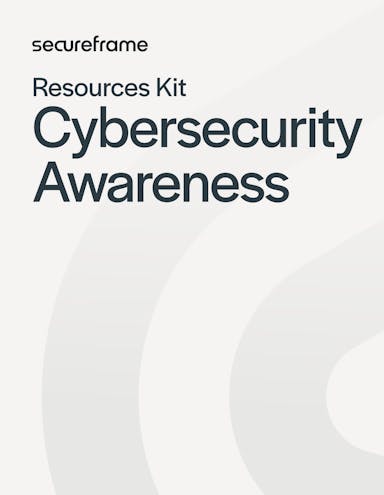
Practical Ways to Strengthen Cybersecurity Awareness Across Your Team
Emily Bonnie
Senior Content Marketing Manager
Rob Gutierrez
Senior Cybersecurity and Compliance Manager, CISA, CCSK, CMMC RP
If you run a business, you already know cyber threats aren’t just a concern for tech giants or critical infrastructure. Cybercrime affects organizations of every size, from financial institutions and healthcare providers to startups and small businesses. A single phishing email, misconfigured cloud system, or compromised vendor can expose sensitive information and disrupt operations overnight.
The average cost of a U.S. data breach is now $10.22 million, and phishing-related cyber attacks now average $4.8 million per incident. Even more concerning, 60% of breaches involve the human element, a stark reminder that employees remain both the biggest risk and the best defense. Many successful attacks work not because defenses are missing, but because people don’t know what today’s online threats look like, how they unfold, or what to do when they encounter one.
That’s why cybersecurity awareness is so essential. It’s one of the most cost-effective ways to reduce cybersecurity risks and protect your information systems.
The tangible benefits of cybersecurity awareness
Cybersecurity awareness turns employees from soft targets into active sensors and first responders. When people can spot a fake invoice, pause before approving a wire, or report a suspicious login alert quickly, your likelihood of a costly incident drops and your ability to contain an issue rises.
At scale, those small actions add up. Companies that extensively use modern awareness training and supporting technologies detect and contain breaches 80 days faster and save nearly $1.9 million on average compared to those that don’t. Awareness also reduces the frequency of mistakes, from mishandling PII to reusing weak passwords. For example, teaching employees to use a password manager and create unique passwords makes credential-based attacks far less likely to succeed.
Cybersecurity awareness is also central to many security and regulatory frameworks, which require organizations to train staff on cybersecurity best practices. Beyond compliance, investing in awareness creates a culture where everyone, not just IT, shares responsibility for protecting the business.
Recommended reading

110+ of the Latest Data Breach Statistics to Know for 2026 & Beyond
DHS and CISA Cybersecurity Awareness Month
Cybersecurity awareness is such a priority that the U.S. Department of Homeland Security and CISA designate October as Cybersecurity Awareness Month, now more than twenty years running. The campaign brings together partnerships across government and the private sector, focusing on this year’s theme of practical steps businesses can take to stay safe online.
This month can be a great opportunity to launch or refresh your own cybersecurity awareness program. By tying your internal training to a national campaign, you give employees a clear signal: cybersecurity awareness is part of how we work, not a side project.
Just remember, awareness month is just the starting line. To make a real impact, it needs to be integrated into everyday operations year-round.
Why cybersecurity awareness is more than annual training
An annual e-learning module may check a compliance box, but it rarely changes behavior. Attackers won’t wait eleven months for your next refresher, and neither should you.
Cybersecurity awareness should be built into daily workflows through clear policies and practical exercises. That means short, frequent training sessions instead of one marathon module. It means tailoring lessons to the actual cyber threats your business faces, rather than using generic examples. It also means adapting training to different roles, because the risks facing your finance team aren’t the same as those facing HR, engineering, or executives.
Hands-on practice is just as important as regular training. A written incident response plan is useless if no one has rehearsed it. Employees should be able to recognize suspicious activity, know who to notify, and feel confident acting quickly under pressure. And they’ll only get there by practicing in realistic, low-stakes settings.
Finally, awareness needs to be supported by a culture of openness. Reporting should be easy, encouraged, and non-punitive. When employees know they won’t be blamed for clicking a link or asking a question, they’re far more likely to raise concerns early when a problem is still manageable.
To be effective, cybersecurity awareness can’t be a once-a-year event. It needs to be an ongoing business process that builds resilience, reduces mistakes, and strengthens your team’s ability to respond effectively when online threats strike.
Recommended reading

11 Tips to Effectively Reduce Human Errors in the Workplace
Building a cybersecurity awareness program that protects your business
If you’re starting from scratch, it can be difficult to know where to begin. Here are some practical ways to start small, gain momentum, and keep your cybersecurity awareness program useful year-round.
Bring the right people together
Start with a cross-functional working group. Involve one executive sponsor, your security or IT lead, HR or Learning, a communications partner, and a couple of business-unit leaders from higher-risk areas like Finance or Sales Ops. Each has a defined role:
- Security/IT designs the program, runs simulations, and handles incident triage.
- HR/Learning manages enrollments, reminders, and compliance tracking.
- Communications ensure messages are clear, consistent, and well-placed.
- Business units co-own role-specific training and help keep examples relevant.
- The executive sponsor provides cover from the top, removes blockers, and asks for progress updates.
This group ensures the program isn’t siloed in IT but embedded across the organization.
Identify your top risks
In your first session, list the five biggest cybersecurity risks facing your business in plain language. Maybe it’s phishing and business email compromise (BEC), mishandling of sensitive customer data, or insecure third-party access.
This way you can teach the threats that actually target your business, not generic examples. If you send invoices, use real look-alike samples to teach staff what a fake looks like. If you rely on a CRM or cloud file-sharing, show how misconfigurations can turn into breaches. If you handle healthcare data, emphasize HIPAA requirements and safe data sharing. Generic content won’t stick; real-world examples will.
Recommended reading

Understanding the Cyber Threat Landscape: 15 Most Common Types of Cyberattacks
Deliver shorter, more frequent training
Long, once-a-year courses are difficult to retain. Instead, schedule short, quarterly sessions that each focus on one risk area. For example:
- Q1: spotting phishing and invoice fraud
- Q2: using strong passwords and multi-factor authentication
- Q3: safe file-sharing and cloud collaboration
- Q4: incident response basics
Keep each module 10–15 minutes long, delivered in plain language, and tied to a single action you want employees to take. Reinforce with quick monthly reminders, like a one-minute demo in an all-hands meeting or a short tip in Slack or Teams. These small, repeated touchpoints are what turn knowledge into habit.
Personalize awareness training for high-risk teams
Not every team faces the same cybersecurity risks, which is why generic, one-size-fits-all training often falls short. Tailoring awareness to specific roles makes the lessons stick and helps employees connect the dots to their daily work.
For example, finance teams are frequent targets of business email compromise and invoice fraud, so they should regularly practice verifying vendor bank changes and spotting payment scams. HR handles large volumes of sensitive personal data and manages access to systems, making them critical in preventing insider threats during onboarding and offboarding. Engineering teams benefit from refreshers on vulnerability hygiene and secure coding practices, but also on how to avoid accidental spillage of sensitive information into logs, repositories, or collaboration tools. Executives, meanwhile, need to understand how attackers use social engineering to impersonate trusted contacts, how to recognize early warning signs of insider threats, and how to communicate clearly if an incident does occur.
By connecting training directly to the responsibilities and risks of each group, you turn abstract cyber threats into practical lessons employees can act on with confidence.
Launch an easy reporting channel
Place a “Report Phish” button directly in your email client. Microsoft 365 and Google Workspace both support add-ins that let users flag suspicious messages with one click.
If you don’t have that option, create a simple reporting email alias like phish@company.com or security@company.com and make sure it’s monitored. You can also set up a Slack or Microsoft Teams shortcut that posts reports into a dedicated security channel.
Don’t stop at internal channels. Many companies now list a reporting address or form on their website, trust center, or security page. This gives customers, partners, or even external researchers a clear way to share suspicious activity or report vulnerabilities responsibly.
The key is to remove friction. Employees shouldn’t have to wonder who to tell or how to escalate. Pair these channels with a clear message: reporting quickly helps the company, even if someone clicked the link. When people know they won’t get in trouble for making a mistake, they’re far more likely to raise their hand early when the issue is still manageable.
Run realistic simulations and tabletops
Awareness sticks best when employees get to apply what they’ve learned in safe, controlled scenarios. Start with simple, frequent exercises like simulated phishing emails or “spot the red flags” challenges. These give people a chance to practice pausing, inspecting, and deciding how to respond.
From there, move to larger-scale exercises. Tabletop exercises let teams walk through an incident step by step, talking through who would notice the issue, who should be alerted, and how communications would flow. This is where your incident response plan comes off the page and gets put into practice. Assign roles, run through a realistic scenario like a ransomware outbreak or a vendor compromise, and track how long it takes to triage, escalate, and notify the right people.
Finally, make practice an ongoing cycle. Repeat scenarios periodically or on a scheduled cadence based on internal policies, rotate who participates, and update the playbook whenever staff, systems, or tools change. That way, when a real cyber attack happens, your team isn’t improvising under pressure; they’re following a playbook they’ve already run before.
Recommended reading

How to Run Effective Cybersecurity Tabletop Exercises + 6 Scenario Templates
Publish clear policies and procedures
Policies are only useful if people understand and use them. Take long policy and procedure documents and turn them into short, practical playbooks with checklists. For example, “How to verify a vendor bank charge,” or “What to do after losing a laptop.” Make these guides easy to find by pinning them to team Slack channels, in your company folders, and linking them in your training modules.
Decide how you’ll measure success
Without metrics, you won’t know if the program is working. Track a handful of KPIs that reflect both learning and behavior: phishing-click rates, time-to-report, training completion, incident response times, and the number of fraudulent payments prevented.
Review these monthly and look for trends. Are employees reporting faster? Are click rates going down? Is containment improving? Look for steady progress and evidence that awareness is reducing real-world risk.
To make this process easier, many organizations turn to GRC automation platforms. These tools centralize data from training systems, incident reports, and phishing simulations, giving you a single place to track performance and generate dashboards for leadership. Instead of manually compiling spreadsheets, automation can highlight risk trends, flag repeat issues, and document improvements over time, making your awareness program easier to manage and more transparent to stakeholders.
Refresh and improve
Once a year, run a half-day review: look at the year’s incidents and near-misses, the KPI trends, and changes in your technology stack or vendor list. Update your playbooks, tabletop scenarios, and the four quarterly modules for the next year. If you are adding new vendors or tools, fold those into your role-based refreshers. This is also a good time to realign with CISA’s October Cybersecurity Awareness campaign if you want to launch new content with extra visibility.
Download a cybersecurity awareness toolkit
Secureframe exists to make strong cybersecurity programs easier to build and maintain, especially for growing teams. We combine automated evidence collection, policy management, third-party risk workflows, and awareness training content so you can put practical security measures into practice.
While automation and AI can speed up detection and response, the foundation is still a workforce that understands threats and knows how to act. If you want a head start, we offer a free cybersecurity awareness kit with templates and checklists designed to help your team prepare for incidents, assess risks, and practice real-world scenarios before they happen. Pair it with CISA’s October campaign materials to give your internal rollout extra momentum.

Cybersecurity Awareness Kit
Building a strong cybersecurity program can feel overwhelming, especially for growing teams with limited time and resources. This free Cybersecurity Awareness Kit brings together essential tools so you can train employees, test your defenses, and improve resilience.
FAQs
When is Cybersecurity Awareness Month?
Cybersecurity Awareness Month takes place every October. It’s led by the Cybersecurity and Infrastructure Security Agency (CISA) and the National Cybersecurity Alliance, with support from the U.S. government and private sector partners. Each year has a theme and campaign materials to help organizations raise awareness and encourage people to stay safe online.
How to improve cybersecurity awareness?
Start by making training more frequent and relevant. Replace long annual courses with short, quarterly modules focused on real threats your business faces, like phishing or social engineering. Add role-specific refreshers for high-risk teams, run phishing simulations and tabletop exercises, and make reporting easy with tools like a “Report Phish” button in your email client.
What are the benefits of cybersecurity awareness?
A workforce that understands cyber threats is less likely to fall victim to attacks and more likely to report issues early. Awareness programs reduce costly mistakes, shorten response times, and build a culture where security is everyone’s responsibility. Research shows companies with strong awareness and supporting technology detect breaches faster and save significantly on breach costs.
What resources are available for cybersecurity awareness?
Organizations can use free materials from CISA and the National Cybersecurity Alliance during Cybersecurity Awareness Month, plus templates and toolkits from trusted providers like Secureframe. Our Cybersecurity Awareness Kit includes an incident response plan, risk assessment template, tabletop exercise scripts, and a 2026 cybersecurity checklist to help you build a practical, sustainable program.
What are some cybersecurity awareness activities for employees?
Awareness sticks when employees get to practice in realistic but safe scenarios. Consider adding:
- A monthly “spot the phish” challenge with screenshots of real-world emails.
- Quarterly phishing simulations with immediate feedback and coaching.
- Lunch-and-learn sessions where your security lead explains a recent cyber attack in your industry and how it could apply to your business.
- Rotating tabletop exercises covering ransomware, vendor compromise, or accidental data sharing.
- Role-specific drills for finance, sales, HR, and engineering, focusing on the risks that matter most to each group.
The more employees engage with real scenarios, the more likely they’ll recognize and respond effectively when it happens for real.

Emily Bonnie
Senior Content Marketing Manager
Emily Bonnie is a seasoned digital marketing strategist with over ten years of experience creating content that attracts, engages, and converts for leading SaaS companies. At Secureframe, she helps demystify complex governance, risk, and compliance (GRC) topics, turning technical frameworks and regulations into accessible, actionable guidance. Her work aims to empower organizations of all sizes to strengthen their security posture, streamline compliance, and build lasting trust with customers.

Rob Gutierrez
Senior Cybersecurity and Compliance Manager, CISA, CCSK, CMMC RP
Rob Gutierrez is an information security leader with nearly a decade of experience in GRC, IT audit, cybersecurity, FedRAMP, cloud, and supply chain assessments. As a former auditor and security consultant, Rob performed and managed CMMC, FedRAMP, FISMA, and other security and regulatory audits. At Secureframe, he’s helped hundreds of customers achieve compliance with federal and commercial frameworks, including NIST 800-171, NIST 800-53, FedRAMP, CMMC, SOC 2, and ISO 27001.